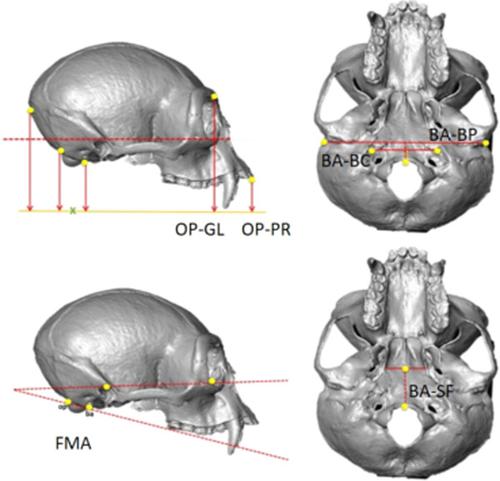当前位置:
X-MOL 学术
›
Am. J. Primatol.
›
论文详情
Our official English website, www.x-mol.net, welcomes your
feedback! (Note: you will need to create a separate account there.)
Locomotion, posture, and the foramen magnum in primates: Reliability of indices and insights into hominin bipedalism.
American Journal of Primatology ( IF 2.0 ) Pub Date : 2020-07-08 , DOI: 10.1002/ajp.23170 Federica Landi 1 , Antonio Profico 2 , Alessio Veneziano 3 , Isabelle De Groote 4 , Giorgio Manzi 5
American Journal of Primatology ( IF 2.0 ) Pub Date : 2020-07-08 , DOI: 10.1002/ajp.23170 Federica Landi 1 , Antonio Profico 2 , Alessio Veneziano 3 , Isabelle De Groote 4 , Giorgio Manzi 5
Affiliation

|
The position (FMP) and orientation (FMO) of the foramen magnum have been used as proxies for locomotion and posture in extant and extinct primates. Several indices have been designed to quantify FMP and FMO but their application has led to conflicting results. Here, we test six widely used indices and two approaches (univariate and multivariate) for their capability to discriminate between postural and locomotor types in extant primates and fossil hominins. We then look at the locomotion of australopithecines and Homo on the base of these new findings. The following measurements are used: the opisthocranion–prosthion (OP–PR) and the opisthocranion–glabella (OP–GL) indices, the basion–biporion (BA–BP) and basion–bicarotid chords, the foramen magnum angle (FMA), and the basion–sphenoccipital ratio. After exploring the indices variability using principal component analysis, pairwise comparisons are performed to test for the association between each index and the locomotor and postural habits. Cranial size and phylogeny are taken into account. Our analysis indicates that none of the indices or approaches provides complete discrimination across locomotor and postural categories, although some differences are highlighted. FMA and BA–BP distinguish respectively obligate and facultative bipeds from all other groups. For what concerns posture, orthogrades and pronogrades differ with respects to OP–PR, OP–GL, and FMA. Although the multivariate approach seems to have some discrimination power, the results are most likely driven by facial and neurocranial variability embedded in some of the indices. These results demonstrate that indices relying on the anteroposterior positioning of the foramen may not be appropriate proxies for locomotion among primates. The assumptions about locomotor and postural habits in fossil hominins based on foramen magnum indices should be revised in light of these new findings.
中文翻译:

运动,姿势和灵长类动物的大孔:指数的可靠性和人均两足动物的见解。
大孔的位置(FMP)和方向(FMO)已用作现存和已灭绝灵长类动物运动和姿势的代理。已经设计了一些指数来量化FMP和FMO,但是它们的应用导致了相互矛盾的结果。在这里,我们测试了六个广泛使用的指数和两种方法(单变量和多变量),以区分现存的灵长类动物和化石人类素中的姿势类型和运动类型。然后,我们看一下南澳大利亚古猿和人的运动在这些新发现的基础上。使用以下测量:骨膜假体隆突(OP-PR)和骨膜-glabella指数(OP-GL)指数,胫骨双孔(BA-BP)和胫骨-双头肋骨弦,孔大头角(FMA),以及底-枕骨比。使用主成分分析探索指标的可变性后,进行成对比较以测试每个指标与运动和姿势习惯之间的关联。考虑到颅骨的大小和系统发育。我们的分析表明,尽管突出了一些差异,但没有任何指标或方法可以完全区分运动和姿势类别。FMA和BA-BP分别将专性两足动物和兼性两足动物与所有其他人群区分开。对于姿势,原教统统和原教统统在OP-PR,OP-GL和FMA方面有所不同。尽管多元方法似乎具有一定的判别力,但结果很可能是由某些指数中嵌入的面部和神经颅变异性驱动的。这些结果表明,依赖于孔的前后位置的索引可能不是灵长类动物运动的合适代理。应根据这些新发现,对基于孔大瓶指数的化石人族素中运动和姿势习惯的假设进行修订。这些结果表明,依赖于孔的前后位置的索引可能不是灵长类动物运动的合适代理。应根据这些新发现,对基于孔大瓶指数的化石人族素中运动和姿势习惯的假设进行修订。这些结果表明,依赖于孔的前后位置的索引可能不是灵长类动物运动的合适代理。应根据这些新发现,对基于孔大瓶指数的化石人类素中运动和姿势习惯的假设进行修改。
更新日期:2020-08-26
中文翻译:

运动,姿势和灵长类动物的大孔:指数的可靠性和人均两足动物的见解。
大孔的位置(FMP)和方向(FMO)已用作现存和已灭绝灵长类动物运动和姿势的代理。已经设计了一些指数来量化FMP和FMO,但是它们的应用导致了相互矛盾的结果。在这里,我们测试了六个广泛使用的指数和两种方法(单变量和多变量),以区分现存的灵长类动物和化石人类素中的姿势类型和运动类型。然后,我们看一下南澳大利亚古猿和人的运动在这些新发现的基础上。使用以下测量:骨膜假体隆突(OP-PR)和骨膜-glabella指数(OP-GL)指数,胫骨双孔(BA-BP)和胫骨-双头肋骨弦,孔大头角(FMA),以及底-枕骨比。使用主成分分析探索指标的可变性后,进行成对比较以测试每个指标与运动和姿势习惯之间的关联。考虑到颅骨的大小和系统发育。我们的分析表明,尽管突出了一些差异,但没有任何指标或方法可以完全区分运动和姿势类别。FMA和BA-BP分别将专性两足动物和兼性两足动物与所有其他人群区分开。对于姿势,原教统统和原教统统在OP-PR,OP-GL和FMA方面有所不同。尽管多元方法似乎具有一定的判别力,但结果很可能是由某些指数中嵌入的面部和神经颅变异性驱动的。这些结果表明,依赖于孔的前后位置的索引可能不是灵长类动物运动的合适代理。应根据这些新发现,对基于孔大瓶指数的化石人族素中运动和姿势习惯的假设进行修订。这些结果表明,依赖于孔的前后位置的索引可能不是灵长类动物运动的合适代理。应根据这些新发现,对基于孔大瓶指数的化石人族素中运动和姿势习惯的假设进行修订。这些结果表明,依赖于孔的前后位置的索引可能不是灵长类动物运动的合适代理。应根据这些新发现,对基于孔大瓶指数的化石人类素中运动和姿势习惯的假设进行修改。











































 京公网安备 11010802027423号
京公网安备 11010802027423号